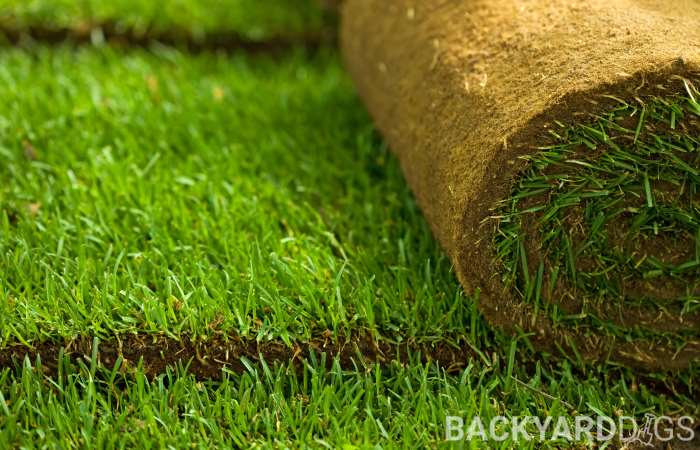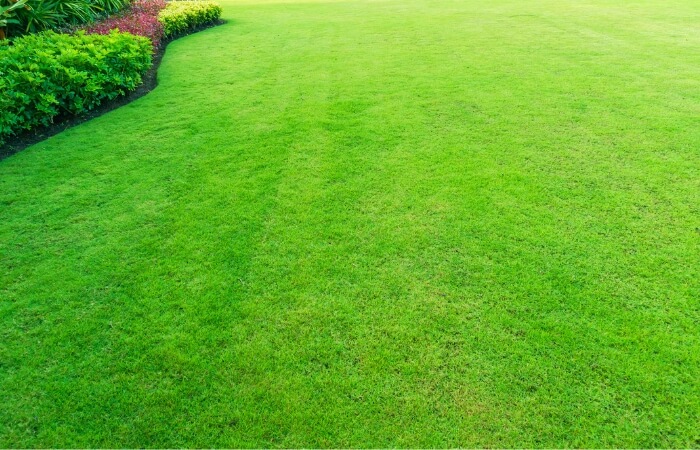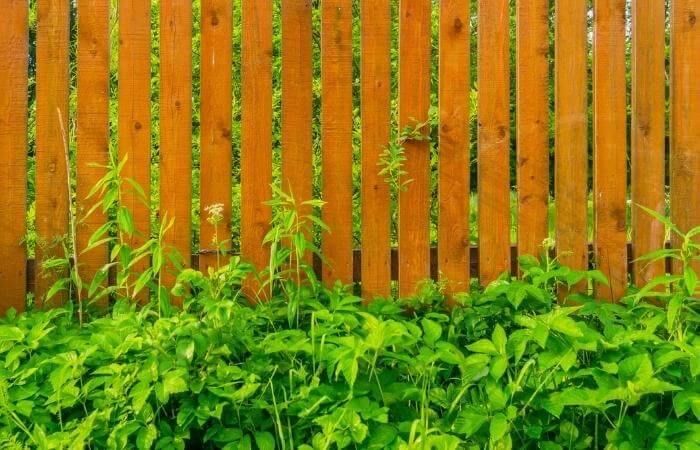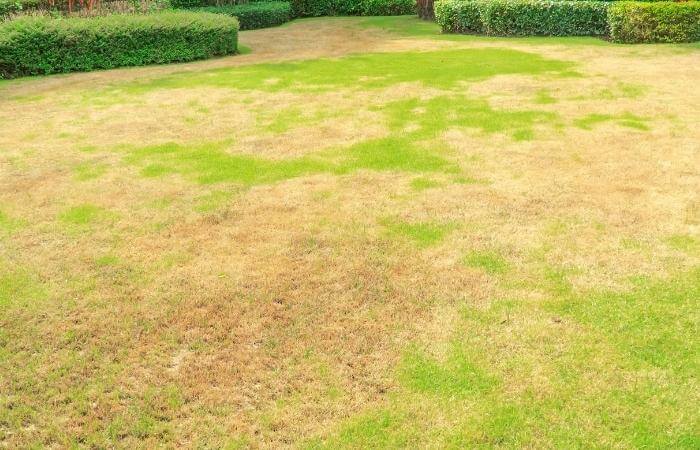Want a lush lawn quick?
Sod and hydroseeding are the way to go, but what is the difference between them?

Sod provides an instant lawn using a tuff of pre-grown grass that looks great while the root system establishes. Hydroseed is a cheaper grass seeding option using a seed spray mix that grows faster than standard methods of lawn seeding.
In this guide, I get into the differences of hydroseeding vs. sod, including prep, maintenance, and cost. I also delve into the pros and cons of each method.
I have used both hydroseeding and sod over the years, so I can attest they are great ways to turn your yard into a luxurious carpet of grass swiftly!
What Is Sod?
Sod starts as grass that is grown commercially on large plots of farmland.
When the grass is thick, a machine slices a section out of the ground just under the root system. These sections are sold flat (usually in a 16-inch by 24-inch piece) or rolled (typically a 2-foot by 5-foot piece).
When growing sod, the farmer maintains the health of the grass by watering and using fertilizers and pesticides, so the grass is thick with little to no weeds.
Sod is the quickest way to have a useable lawn if you treat it correctly.
Related | How Deep Do Grass Roots Grow?
Preparation for laying sod
The best surface for sod is a yard free of existing weeds or grass. For best results, using compost with dirt or other material to balance soil texture.
The pH level of the topsoil should also be correct for the type of grass you chose for your sod. The ground should be level and free of rocks, so the turf can establish a firm grip until the roots can take hold.
Installation
Sod is quick, yet labor-intensive to install. I have put down sod several times by myself. You can also hire contractors who specialize in sodding lawns.
I found the project to be simple, even if my back was sore by the end of the day.
- Find your starting point and roll out or lay a piece of sod in place. Tamp it down slightly into the soil, then begin again with another piece.
- Lay the sod pieces end to end and side by side, while firmly pushing the edges together.
- Use a knife, such as the Keyfit Tools SOD Knife on Amazon, to remove any excess grass around sidewalks and planters. You can cut sod to any shape, so fitting around curves is a breeze.
It’s best to lay sod in the spring and fall when the weather is cooler. You can lay sod in the summer, but expect to spend more time and money keeping it watered.
How long till you can walk on sod?
While you can walk on sod immediately, for best results, refrain from walking on the lawn for the first two weeks.
This break allows the root system to grow into the undersoil. Constant pressure from kids running around could damage the roots and grass.
Pros And Cons Of Sod
Sod does have advantages and disadvantages versus hydroseeding your lawn. Next, I list out the pros and cons, so you have a better idea of whether or not sod is the right choice for you.
Pros:
- Instant gratification. Your lawn is lush immediately.
- Sod creates a denser lawn, with no bare or thin spots that would need reseeding.
- Sodding a small lawn can be time/cost-effective versus hydroseeding.
- Sod stops soil erosion and lessens dust in the air as soon as it’s down.
Cons:
- Labor intensive. You must lift, carry, and position each piece of sod.
- Cost – sod is more expensive to buy, with professional installation adding more to the final bill.
- It needs lots of water. Expect to water two times a day for the first month.
- Few grass variety options. Most sod farmers only grow the most tolerant grass variety for their region.
What Is Hydroseeding?
Hydroseeding is a process of taking a mixture of grass seed, fertilizer, bonding agents, wood-fiber mulch, and water and spraying it over bare soil with a hose.
The grass seed is suspended within this “blanket” material that also provides a bit of shade and moisture retention while the roots establish.
See our guide on the best soil moisture meters to help gauge your soil moisture levels before getting started.
The significant benefit of this mixture is that the seeds germinate faster than standard grass seeding methods since the seed stays wet, fed, and in contact with the soil at all times.
Expect to see the initial grass growth in about a week, with the secondary seed variety germinating in two to three weeks.
Two varieties of seed in the mix is typical. The initial grass growth “protects” the secondary seed variety as it grows. Expect to mow the lawn for the first time about four weeks after hydroseeding.
Hydroseeding is most often done by professional contractors who own special trucks and equipment for the job.
Hydroseeding preparation
Hydroseeding needs to lay over bare dirt free of grass and weeds.
Poor soil conditions will derail your plans for a lush lawn. Prep your soil to the correct pH level and texture to ensure quick germination and healthy root development.
Many hydroseeding companies offer soil-preparation services if you are unsure how to handle this part of the process.
Installation
Hydroseeding is less expensive than sod, partly due to the ease of application.
Unfortunately, a special truck and hose are needed to pump the hydroseed mixture onto your property, which means this isn’t a do-it-yourself project.
SEE ALSO: Best Hose Wheel Carts With Wheels
The process is less labor-intensive, with one man able to cover a whole yard in a matter of minutes. The mixture is tinted, so the operator knows which areas are covered.
The best time to hydroseed a lawn is between April and October when seeds naturally germinate.
How long till you can walk on hydroseed?
Aside from mowing, experts recommend you walk on your hydroseed lawn as little as possible for the first few months. The longer you let the roots develop a strong base, the better your yard will look in the future.
While the hydroseed material is still intact, walk carefully across the surface to prevent cracks. Cracks let the moisture out from underneath the mat material, which increases the risk seeds won’t grow properly.
Pros And Cons Of Hydroseeding
Hydroseeding is the happy medium between sod and traditional lawn seeding methods. Let’s take a look at the pros and cons, so you can determine if hydroseeding is best for you.
Pros:
- Hydroseed is approximately 1/3 or less the cost of sod.
- Customers can request a specific seed mixture.
- Hydroseed mixture creates a barrier that helps prevent wind and water erosion.
- Better germination and growth rates over standard seeding.
Cons:
- Hydroseed needs consistent watering-up to four times a day
- Shouldn’t walk on hydroseed lawn for many weeks
- The mixture is a funny shade of green that is unattractive until it dissolves.
In Summary
Sod and hydroseeding both provide your landscape with a beautiful expanse of thick grass in a short period of time.
When you can’t wait for traditional lawn seeding to fill out your yard, this guide shows you quicker methods that can fit within your budget and time constraints.
It’s easier than ever to quickly turn a patch of dirt into a stunning lawn that brings additional value and curb appeal to your home.
Now that you know the difference between hydroseeding versus sod, you can select the ideal option to finish off your home’s landscaping to perfection!










